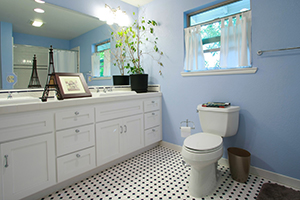Evaporative coolers, also called “swamp coolers” rely on the evaporation of water to cool building air, rather than the movement of a refrigerant through cooling coils. Cooling towers, swamp coolers, and even a simple window fan blowing air across a pan of water and into a room are types of evaporative cooling systems.
Swamp coolers systems may use less energy than a refrigerant-gas and compressor type air conditioner but they’ll only work where the ambient humidity is low enough to make it easy to evaporate water. Climates such as in Escondido, Poway, San Marcos, Vista, and Valley center are relative.
Evaporative cooling system approaches are similar: dry outdoor air is blown across an evaporative cooling device that uses water evaporation to cool the incoming air.
The differences among these swamp cooler designs are principally how the water to be evaporated is delivered to the evaporative cooling device (drum or pad bottom is immersed in a water reservoir pan, or a pump delivers water to the top of the evaporative pad), and the type of evaporative device itself: a rotating drum or an evaporative pad.
8 zones and 8 indoor air conditioning strategies below might be usable.
- Active solar or mechanical heating: this zone has outdoor temperatures too low for passive building environment conditioning strategies.
- Passive solar heating: direct solar gain, indirect solar heat gain, hybrid systems, combined with air infiltration and temperature conduction control.
- Dehumidification: high outdoor (or indoor) humidity requires using some method to remove the excess humidity in order for building occupants to be comfortable.
- Mechanical air conditioning: temperature & humidity combinations in this climate zone cannot be managed by passive means and so mechanical air conditioning & heat pump systems or active solar cooling will be needed.
- Ventilation: although temperatures and humidity may be high, occupants may be made comfortable by direct evaporation of sweat from the skin if enough air velocity is available – in other words, fans can do the trick.
- Thermal mass: these air conditioning systems are usually found in hot-dry climates with dry cool nights, like Escondido, Poway, San Marcos, Vista, and Valley Center. Particularly at higher elevations. Radiant cooling and night-flushing of internal mass with cool outside air stores coolness (the ability to later absorb heat) for the next day, and similarly, during the warmer day, the same thermal mass can store warmth to even out cooler nighttime temperatures indoors.
- Evaporative cooling: low energy “swamp coolers” (discussed in this article) can be used under conditions of low humidity such as Escondido, Poway, San Marcos, Vista, and Valley Center.
- Humidification: moisture needs to be added to very dry air for indoor comfort. We prefer local or room humidifiers after seeing duct, mold, concerns with some centralized humidifier add-ons to heating and air conditioning systems.
For additional Air Conditioning strategies in Escondido or surrounding cities call United Plumbing Heating Air & Electric.





